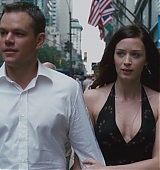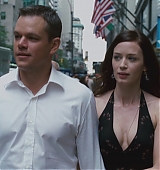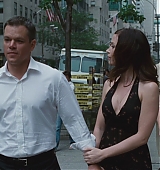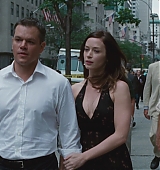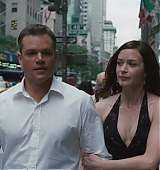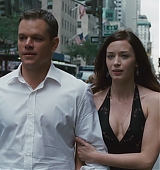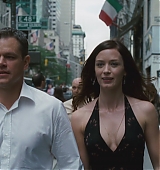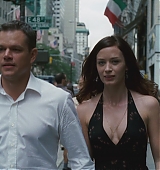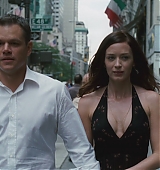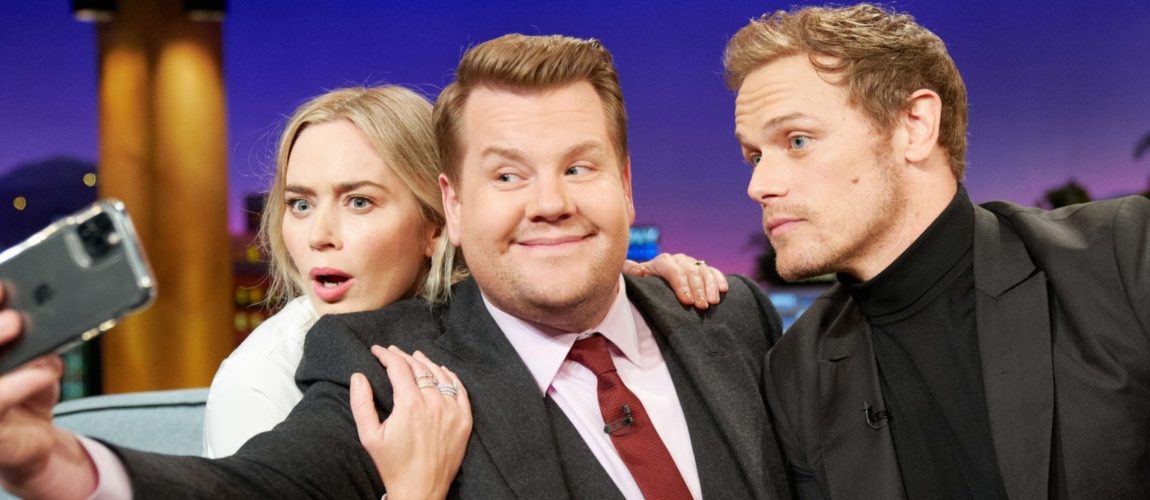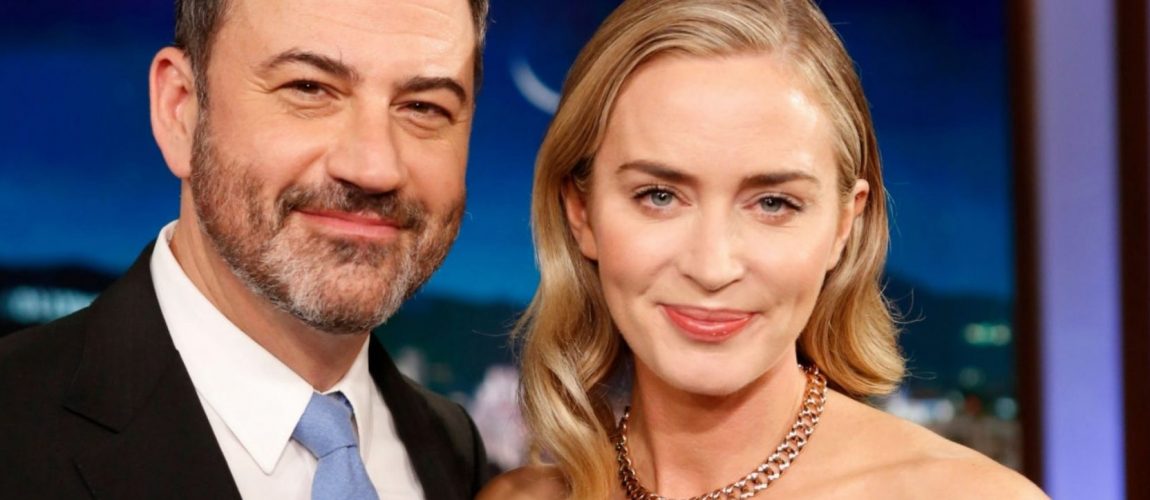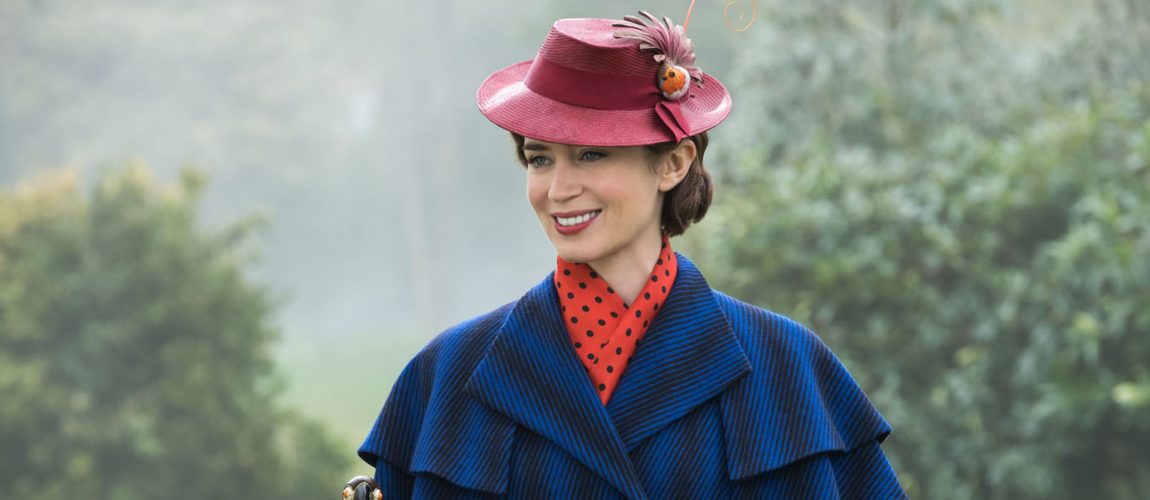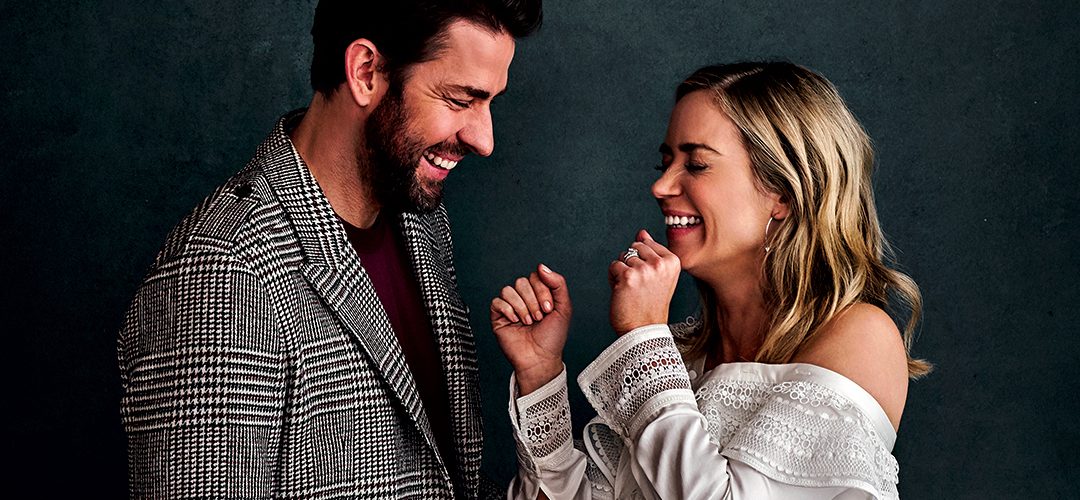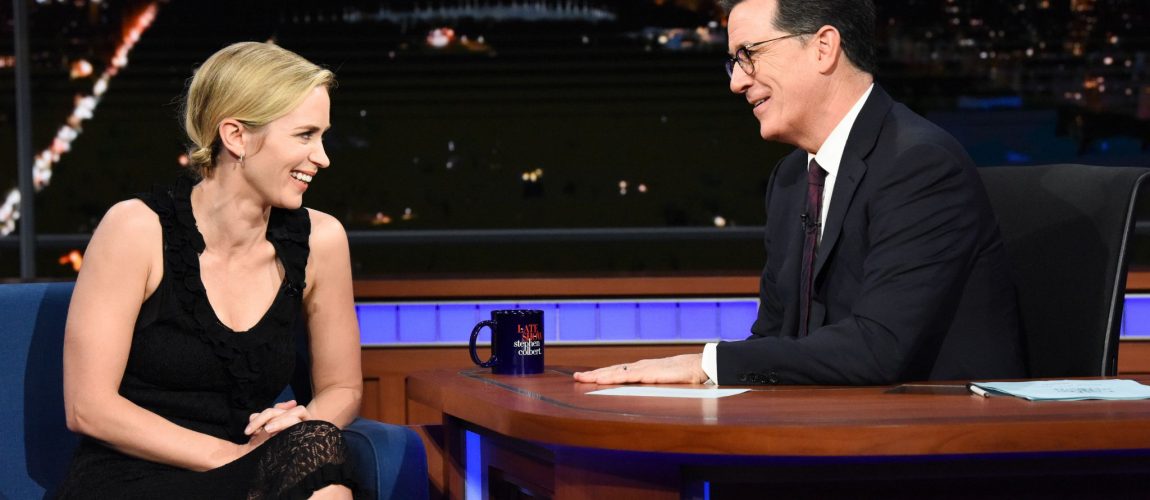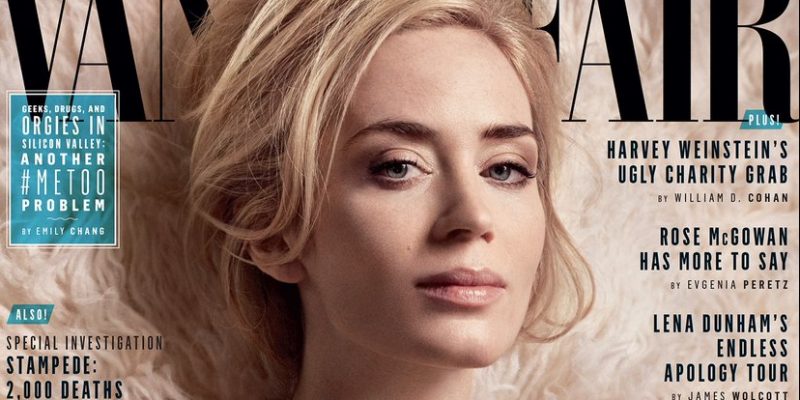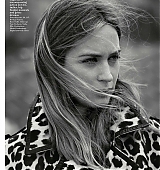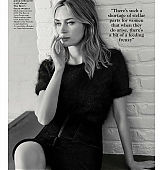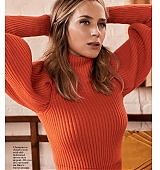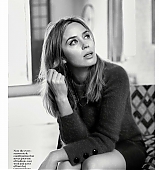Yesterday, Emily visited Late Late Show with James Corden, here are photos and videos:
Category: Interviews
On Tuesday, Emily visited Jimmy Kimmel Live to promote A Quiet Place 2. Here are videos and pictures:
Another great interview, this one is video, from Collider.
Great interview from Deadline:
Though they started dating a decade ago, John Krasinski & Emily Blunt had never worked together before this year, when the Krasinski-directed A Quiet Place cast them as husband and wife and tapped into the unspoken language they’ve come to share. Krasinski was nervous to approach Blunt to star, but on screen, as they navigate a world in which the slightest sound could mean instant death, it’s that real-life connection that telegraphs everything another movie might wrap up in dialogue. The film has been the runaway horror hit of the year, and Kransinki is already at work writing a sequel.
A Quiet Place has had an extraordinary life in the nine months since its release. Could you have predicted this?
Emily Blunt: Has it been nine months? My god!
John Krasinski: We’re ancient. I’ll speak for myself when I say it’s completely and totally surreal. I genuinely don’t know if I’ve processed it yet. We treated it like a neat little indie movie; it felt like an indie movie. We thought it was really special, really unique, and really different, but we were pretty sure we wouldn’t get much more than four or five high-fives from friends. And turns out we have a lot more friends that we didn’t even know about.
Blunt: It has been overwhelmingly exciting for me to see people watch this film and have their hair blown backwards by it. I always thought we would get here. I remember John showed me one little bit of one scene in the early stages of the edit, while he was trying to find the first cut. It was when the basement is flooded with water. I flipped out. I remember saying, “John, this is so cool!” And as he knows, we Brits don’t enthuse too readily, unless we really mean it, so I think he knew I meant it.
People who hate genre movies loved this movie. People who had never seen a horror movie before loved this movie. It has been universal. The afterlife that it has had, it’s not something either of us really know how to contend with, but it’s wonderful.
The movie gives away very little of the backstory on the world, but you had all that information in your head, John. Were you surprised by the questions that came?
Krasinski: I love the idea that people are putting the puzzle pieces together and coming up with theories. I love getting challenged about it. Like, why don’t they just live by the waterfall? I get that question on Twitter all the time. How would they build a house? How would they break ground? People are like, “Oh. Yeah, I guess.”
Blunt: Just live in the waterfall!
Krasinski: Exactly. [laughs] But it was always one of the things Emily and I loved from the very beginning, this idea that if you know more than the family does, the tension goes out of the room. It was a way to bond you to the family quicker. If you feel there’s an answer to all this, you don’t care.
What were the questions that surprised you—that made you think, ‘Damn, I didn’t consider that”?
Krasinski: Well, I was surprised the waterfall question even came up.
Blunt: “How do you fart?” “How do you burp?” “What happens if you have diarrhea?” They’ve been the fun questions for me to watch John get.
Krasinski: I actually had an idea for dealing with that, but I was like, “No, I don’t really want to think about it.”
You had a young boy on set. I can’t believe he didn’t ask those kinds of questions.
Krasinski: You know, it’s interesting you say that, because Noah Jupe was definitely the one with the most questions. In the beginning, he was the one saying, “Can you tell me why this and why that?” He really made me explain, and he was actually really helpful. He was kind of like a temp audience. He said, “I’m not quite sure about this,” and I’d explain to him how we were going to shoot it and he was like, “OK cool, that’ll be cool, I just didn’t know how that happened.”
Emily, John once told me he was nervous to ask you to be in the movie, until you read the script on the plane and insisted on playing the part. But that he’d always wanted it to be you.
Blunt: I’ll be very honest—he never gave me that indication. I was going headfirst into Mary Poppins 2, which was going to be an entire year of my life. I think he knew that I wasn’t in the headspace to sign on to another job right after that. I was already feeling a bit overwhelmed about doing Poppins and we had a brand new baby. For practical, domestic reasons, I think he probably didn’t think I would be into it. I’d actually suggested a friend of mine instead.
We’ve also always been very protective about working together, and I think I probably felt even more protective of not being in this one initially, because I knew it was such a big swing for him. I also knew it could potentially reveal everything that I know about him, and the measure of his talent. I just didn’t want the idea of playing his wife in the movie and being his wife in real life to overwhelm the narrative of what I wanted this moment to be for him.
And then I read the script, and I was like, “Well, I now have to do this movie because it’s so spectacular.” I think all of my protection went out the window because I realized that, of all the projects we’ve been sent to do together—and there’ve been many—it would really serve this film that we were married in real life. I think we have that secret language, and literally everything is unspoken in the film, so you can really feel the weight of that relationship and believe it as soon as you see us on screen.
Krasinski: You always try to write with your dream actor in mind, because it helps you see the performance in your head, and not to mince words, but I think Emily is the best actress we have. Also, I’ve been there firsthand when she has been the very representation of strength and motherhood and fertility; she has superpowers that I will never be able to comprehend. As I wrote the character, it was all filtered through her. So when she said she’d do it, I thought, OK, this movie just got a whole lot easier.
How much does your parenthood spill into these performances?
Blunt: I think to an immeasurable degree. This part was the most personal to me, because everything that she feels about her children, I feel about mine. The line between myself and the character became very blurry for me. I found it a very emotional experience, playing her.
Krasinski: I mean, I think it’s the reason why I did the movie. I’ve talked about it before, but I couldn’t watch a horror movie, let alone make one. The thing with this was the truly overwhelming sense of clarity that hit me, that the movie would be the perfect metaphor for parenthood. Yes, it would be scary. Yes, it would have tension and all those things. But it would also be like writing a love letter for my kids. In every word I wrote, or every shot I directed, and all through the performance.
When we first started talking about it, Emily said it would be the scariest role she’d ever played. I asked her why. She said, “Up until now, every performance has been pretending. Professional pretending. This is the first time I’ve had the same fears as my character.” Not that monsters would come out of the woods to eat the kids, but that thought of, what if I wasn’t there in my kids’ moment of need? It was our biggest fear.
When you’re on set, playing these traumas out, did it help that you had each other?
Krasinski: Without a doubt. It was unilaterally helpful for me, because I had everything going for me with her. I had someone who could deliver a performance when we were running out of time, running out of budget. She would hit her mark, and hit her performance every single time. I had that.
I also had someone that, after she did her scenes, would stay around, and not only be there for me, but be there for the entire cast and crew. These movies become giant energy balls, and you have to feel supported and loved, because that energy is so important. She was my best collaborator. So anytime I felt stuck, or anytime I felt like I had an idea that was just so crazy it might work, it was always nice to run it by someone of this level of taste and dedication, and basically have them say, “Yes, go for it.” I had my best cheerleader beside me the whole time.
Blunt: I feel the same. I think that we do collaborate really well. It turns out we do work really well together. There were scenes that were certainly traumatic to do—like the whole bathtub sequence, and the sequence of the child we lose at the beginning of the film—and you can’t help but be upset by some of those scenes when you’re doing them. They creep under your skin before you know it. But I do feel that John and I are able to find levity in most places, and we certainly drank a lot of whiskey when we got home at night. The drives to work and from work were really amazing times, where we listened to music, and we talked about the day, and downloaded. So there was that ability to escape, certainly in a vat of Macallan Whisky when we got home as well, to decompress.
Krasinski: This movie was sponsored by Macallan Whisky.
Are you trying to get free whisky right now?
Blunt: Oh yes. Macallan 12, please. [laughs]
Krasinski: It has to be Macallan 12.
You’ve been together a while at this point, but was it challenging to find the collaborative language when you first got to set?
Blunt: We did have to, kind of, learn a new way of working together, because we’d always talked to each other about our respective projects, and so this was the first time we were on board with the same thing. And I’m different when I’m at work, but I do feel that John allowed for that in me, because he sees me at home, in the life of domesticity. I asked him if I was different at work, and he said, “You just have a different way about you. There’s something a bit more focused about your personality.”
I think we learned each other’s tics when we were at work. But I also think we very much allowed for them, knowing that we had to offer each other the same diplomacy you’d offer any co-star or director that you’re working with. And there was also a shorthand, which accelerated the process in a beautiful way. I know how alike we think, and I think it’s incredibly helpful to know that we’re very like-minded on so many things. He had very good notes for me. So what was I going to do? Say no just because he’s my husband?
Krasinski: It was the embodiment of a trust exercise. From the moment we started dating we’ve been playing that same trust exercise, and we didn’t work together until we’d known each other for a decade. All those buttons that you know you shouldn’t press right before going out to dinner together, you avoid those same buttons on set. I know all her pressure points, so let’s avoid those at all costs.
We really did treat this movie like our marriage. Honesty at all costs, and compassion and being gentle. That’s what a relationship is. I think there are things that you can really avoid on set, knowing that certain things are coming. She knows my tics, for sure. There will be days where I’m thinking about the budget or something and instead of trying to jump in and change the subject to whatever scenes we’re doing, she knows to just let me think about something for two or three minutes.
One mistake I kept making during the writing process was, I would pitch her scenes that I would get so excited about, and I would say the words, “You’re going to love this.” I would come to realize that Brits immediately retract from a phrase like that. In her head, I could see her saying, “This is actually going to be my least favorite thing.”
Blunt: Joe, you’re British, you can attest to that, right?
Of course. Brits take a phrase like that as though it’s a challenge.
Blunt: Exactly. It’s a challenge. [laughs] It’s so true.
Completing the ensemble are these two young actors. No disrespect to both of you, but the kids really make the movie.
Krasinski: It’s true. And that’s just pure luck, to be honest with you. We were so lucky to get these kids that, in my opinion, are not only two of the greatest actors I’ve ever worked with, but such exceptional humans. The fact that these kids were not only nice enough and sweet enough to portray this, but they were deep enough. They were so smart. I mean, here I was explaining—overly explaining—to a 13-year-old girl [Millicent Simmonds] about feelings of loss, feelings of being an outsider, feelings of being a failure and all these things. She just looked at me with a sense of, I wouldn’t say it was hate, but certainly patience. And then I said, “Do you have a question?” And she said, “No, I know what I’m going to do, I’m ready.” It was the first take of her walking across the bridge. And the way she walks across the bridge, you’re like, “OK, that was dumb, I shouldn’t have talked to her at all.” She had it already. I said, “How did you do that?” And she said, “I read the script.”
How did Millie’s deafness inform the film?
Krasinski: We knew sound was not only going to be a character, but the main character in the film. One of the things I learned a long time ago as an actor, that you get to apply as a director, is you need to leave room for organic moments to happen. You can plan and plan and plan and have everything mapped out, but if you don’t leave a little breathing room for something magical to happen, then it won’t.
So I was open to ideas and moments, and I was watching Millie talk to her mom and I saw that her mom was speaking as she was signing to Millie. I went up to her when Millie walked away and I said, “I saw you speaking, can she hear anything?” And she said, “No, she can’t hear me speak. She’s basically completely deaf except for a low-level rumble.” I remember she called it a rumble. Almost like an ambient sound. So if you crash something behind her, she would hear it, but she’d also feel it and that’s the extent of what she can hear.
I brought this idea of a low-level rumble to my sound designers and I said, “We should create a POV shot; a perspective of Millie’s character that, when you’re with her, all you get is the rumble.” They loved that idea. We called it the “envelope”, and we kept working, working, working on it.
Just before we premiered at SXSW, I pulled Millie’s mom aside and said, “We’ve done something based on what you told us. Can you let us know if we got it right?” That night was a transformative moment for me anyway, but certainly one of the best moments of this whole experience will be Millie’s mom coming up to me sobbing—not even crying, but sobbing—and saying, “You don’t understand. My entire life, the only thing I’ve ever wished was to understand my daughter’s experience every day, and you just gave that to me.”
John, you’re writing the sequel right now. Safe to say you won’t be returning to the front of the camera…
Krasinski: It’s a pretty good promise that I won’t be coming back. Unless I do the Hamlet thing; just sort of float around.
Blunt: Definitely do the Hamlet thing.
Krasinski: People love that, right? I’ll be honest with you: I really didn’t want to do the sequel. It was never built to launch sequels, which we all knew, and the studio knew too. But also, I’m a realist. I know that when you have a success like this, everyone wants to make another one. I told them to go find another filmmaker and writer, and they said, “But don’t you have an idea?” I said, “Yeah, I have a tiny idea,” so they said, “OK, while we’re talking to other people, keep thinking about it. They basically mind-tricked me into wanting to write it.
But the idea for it is pretty simple. I’m writing now—I don’t have it fleshed out—but the thought that occurred to me, that really excited me about it, was that most sequels are about the return of a hero or a villain. You take this character that people loved once and you bring them back, and you have to create a new world around them. We have the exact opposite setup. We have the world, and you can drop whoever you want into that world and everyone feels connected to it. The reason I decided to go back, in the end, was this world is so rich, and it’s so much fun to explore. There are so many different things to see now. Everyone else in the world is experiencing this, so I’m curious to see what that looks like from another perspective.
Meanwhile, Emily, Mary Poppins Returns came out before Christmas. We all have fond memories of that first movie. How do you not lose your mind when you’re asked to reprise a character made so famous by Julie Andrews?
Blunt: I won’t say my trepidation to play her was instantly overwhelmed by the delight of playing her, but I did feel that very strongly. I heard the resounding gasps from all of my friends when I said I was taking on Mary Poppins, which is a thought that can only fill you with dread. You’re taking on something iconic, and you shouldn’t be meddling with such a treasured character. But once I’d decided to do it, I dove in headfirst, because as I was receiving David Magee’s rather exquisite scraps of screenplay, I discovered a whole different version of her that I really couldn’t wait to play. She is rather different in the books, and I just knew that if I were going to take her on, I couldn’t impersonate Julie Andrews’ iconic performance. I had to try and make it something else, because otherwise, why bother?
I really have to credit Rob Marshall with maintaining an atmosphere of such intimacy on set. He kept it so pleasant and collaborative, and it was almost like the gasps became white noise, and I was able to approach her like any other character.
The songs are all so different. Did each of them require a completely different language?
Blunt: They did, and it started with the songwriting. I was lucky enough to be brought into the fold very early on, in 2015. I was workshopping the songs with the amazing Marc Shaiman and Scott Wittman, from a very early stage. When you talk about pressure, when I did the first song, we had waited 54 years to hear her sing again. They wrote three or four different songs, and actually, that one didn’t end up being the chosen one. It wasn’t until we arrived at “Can You Imagine That?”, which is a really special song that really represents who she is, because she connects so deeply and takes you into this world of fantasia and depth, and yet she sort of pretends it isn’t really happening. She’s rather offhand about the whole song, and so it was emblematic not just of the character, but of how I was going to approach her.
And that came from just being able to sit and collaborate with the songwriters about how I saw her, and the qualities that we wanted to represent in her through the music. I did feel it was just a beautiful approach, because I thought the songs were like tailormade suits for me and my choices, all before we arrived on set.
That was the approach for the whole adventure. Rob and I talked at great length about where we’d see the cracks in her. Where do we see behind the sternness; that idea of her being a sort of adrenaline junkie? She absolutely loves these adventures; she lives for them. They’re her outlet. You got to see her sense of childlike wonder in those moments. And you got to see who she really is in these private moments. Where’s the humanity in this superhuman?
So each adventure had a sense of abandon that was so exciting for the kids and that had a very deep message for them, and for Michael Banks, but also that she really enjoyed. It was a fabulous approach to creating a deep message for the audience, too. To do it through magic and fantasia is really exciting.
Have your kids seen the original, or Mary Poppins Returns?
Blunt: So we all watched the original after I wrapped. Of course I saw it as a child, but I chose not to watch it again right before shooting. We watched it as soon as I wrapped, and we were all just completely spellbound. It all came flooding back to me; everything that film had meant to me as a child.
[My daughter] Hazel’s four, and she absolutely adored it. And now my younger one is old enough to watch it too, so actually they both watched it again—like a couple of little traitors—the other night. They love Julie Andrews’ Mary Poppins! [laughs]
They did see my version of it at Thanksgiving. We did a little screening for John’s family, and Hazel came to see it and she absolutely loved it. She just thought it was incredible, and she talks about it all the time. She now asks me to do the Mary Poppins voice for her, which is the most surreal thing in the world, to be honest.
Isn’t that every parent’s dream? To be cool in the eyes of their children?
Blunt: Well it won’t last long. I feel like once they’re in their teen years, they’ll immediately sink John and I to the very rock bottom of cool. So I’m going to enjoy it while I can, for the next 10 years.
Watch below Emily’s full interview on Live With Kelly and Ryan. She talks about A Quiet Place, her upcoming movie Mary Poppins Returns and more.
During production of the thriller movie “A Quiet Place,” Emily Blunt said her marriage with co-star and director John Krasinski became stronger, contrary to warnings from others. In this week’s Sunday Sitdown, the British-born actress talks to Willie Geist about working with her husband as well as what it’s like to have the stamp of approval from “The Devil Wears Prada” co-star Meryl Streep and the original Mary Poppins, Julie Andrews.
Yesterday, Emily visited Magic Radio early in the morning and Graham Norton alongside her husband and ‘A Quiet Place’ co-star John Krasinski. Our gallery was updated with promotional images from both shows and we will update this post as soon as we get videos from their appearances.
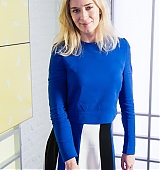
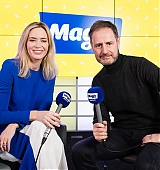
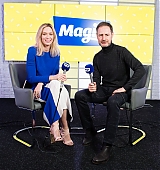

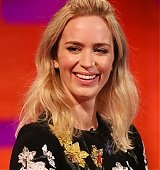
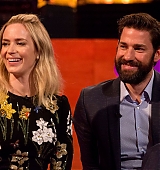

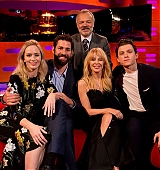
‘A Quiet Place’ star Emily Blunt discusses the enjoyment of playing Mary Poppins, and the strange feeling she gets when thinking about the character.
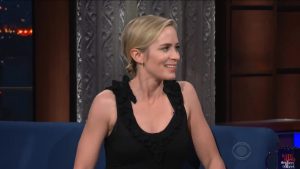

Talk Shows > The Late Show with Stephen Colbert – 29th March 2018 [+375]
Emily is the cover of Vanity Fair’s February 2018 Issue with a photoshoot by Craig McDean. You can find the beautiful shoot on our gallery and the magazine scans will be added soon.



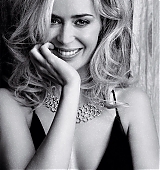
Emily Blunt has sparred with Meryl Streep (twice), out-action-starred Tom Cruise, and ruled the British Empire on-screen. But on this blustery Brooklyn afternoon in November, the 34-year-old English-born actress—surprisingly delicate in person, given the strength she projects on film—is perched on a window seat in a Cobble Hill café, laughing about her first professional heartbreak.
Blunt was 18 and playing Judi Dench’s granddaughter in the 2001 West End production of The Royal Family. If this scenario sounds ludicrously heaven-sent, know that Blunt is the first to admit it. She never intended to act professionally (the hobby was an antidote to a childhood stutter), but there she was. Blunt, who was still living with her parents in London, had no formal training. And Dench—fresh off her Shakespeare in Love Oscar win—had kindly taken her under her wing.
Emily has been a few couple of Talk Shows the past weeks, here are stills:
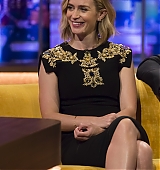
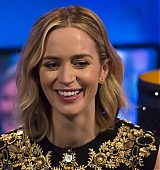
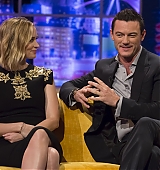

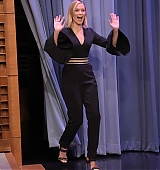

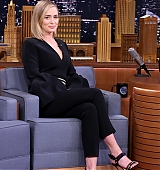
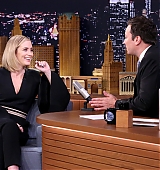
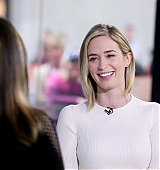
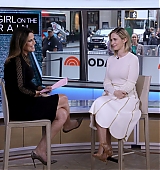

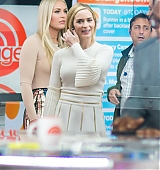
Interviews & TV Appearances > Talk Shows > Tonight Show With Jimmy Fallon – 3rd October 2016
Interviews & TV Appearances > Talk Shows > Today Show – 4th October 2016
Emily is the cover feature of November issue of InStyle, here’s the article, and scans will come soon!
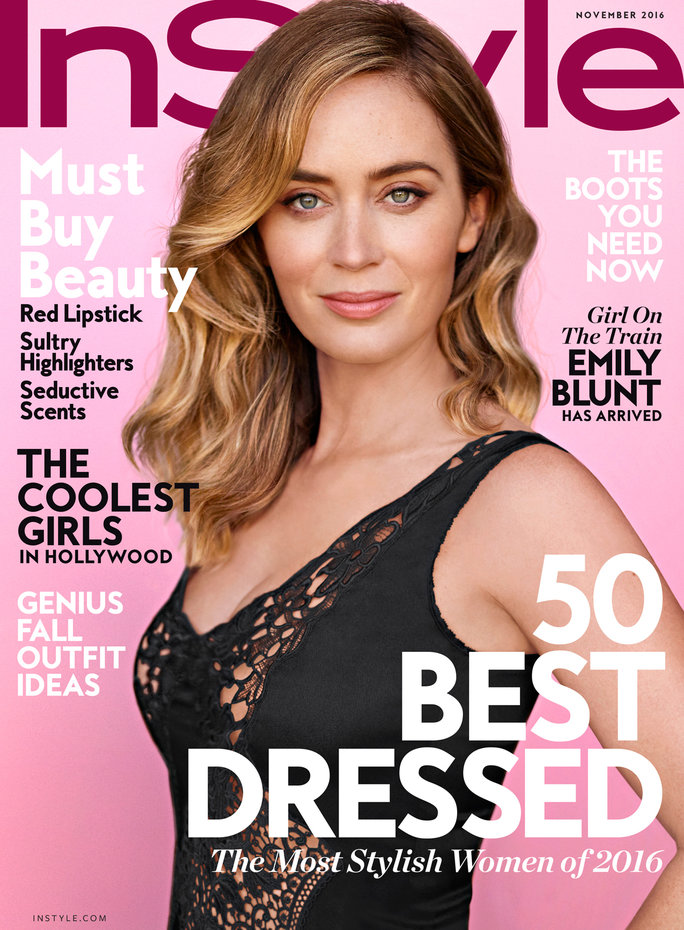
Girl on the Train Star Emily Blunt on Playing a Drunk, Overcoming a Stutter, and Keeping a Low Profile
It wasn’t easy transforming Emily Blunt into a bloated alcoholic for her starring role in the highly anticipated thriller The Girl on the Train. First, there were the cheek plumpers. “The prosthetic people created these molds that clipped onto my teeth to make my face seem puffy,” says Blunt, who, along with her makeup artist, Kyra Panchenko, studied mug shots of drunk drivers to get the look just right. “When we were filming, we were very specific about where she was during the day: how drunk she was, whether or not she was hungover,” says Blunt. “Kyra is so talented. She used gray eye shadow under my eyes to bring out the circles and a little brush to paint spider veins all over my face.” And perhaps the strangest act of makeup subterfuge? A series of bloodshot contact lenses that were switched based on her level of intoxication (pink for tipsy, red for drunk, yellow for hungover). “She’s beautiful, so it was quite hard to make her look horrible,” says Tate Taylor, who directed the film. “I kept saying to the crew, ‘All right, can we get them back in here and make her look a little more drunk and ugly?’ ”
At first, Blunt admits, it was challenging to wrap her mind around the character, a depressed alcoholic who is obsessed with her ex-husband and his new wife (not to mention a random couple who lives a few doors down from them). “The way I live my life is just so dissimilar,” says the actress, who was pregnant with her second daughter, Violet, during filming. To prep for the role, she watched episodes of the documentary series Intervention. “I needed to understand what addiction does to you physically and mentally and how it affects your self-esteem. This woman I play onscreen is so damaged, so broken down, that people don’t even want to breathe the same air as her.”
The exact opposite could be said for Blunt. When we meet for lunch at a cozy local restaurant near the new Brooklyn home she shares with her husband, actor John Krasinski (The Office), and daughters Hazel, 2, and Violet, 5 months, she radiates a kind of low-key, self-deprecating charisma that is hard to resist. Glowing with the flush of new motherhood and fresh off a round of publicity and photo shoots tied to The Girl on the Train, she breezes into the restaurant like some sort of Hollywood unicorn: an actress who is utterly enchanting yet completely unaffected. “I’m still breast-feeding, so I am hungry all the time,” she tells me as she scans the menu. Dressed in cream culottes and a transparent black blouse from Maison Scotch, she looks like a slightly grown-up and more sophisticated version of her famous Devil Wears Prada character. Imagine Emily as an upgraded Miranda Priestly, editor-in-chief of Runway, all clean lines and sumptuous fabrics. “I love a high-waist slouchy trouser,” she says, casually regarding her outfit. “I’m off jeans at the moment.” As she speaks, she runs her hands over a gold Jennifer Fisher necklace that dangles from her neck. “I have a J and an E, and I’m going to get the girls’ names engraved on this,” she says, pointing to a blank gold bar. She and Krasinski chose the names Hazel and Violet because they liked their “antique” British vibe. “They sound like two little old ladies,” says Blunt with a laugh. “They should be playing bridge or something.”
Eight weeks postpartum, Blunt is still adjusting to the reality of having a newborn again. “After we got home from the hospital, I didn’t shower for a week, and then John and I were like, ‘Let’s go out for dinner.’ I could last only about an hour because my boobs were exploding. When the milk first comes in, it’s like a tsunami. But we went, just to prove to ourselves that we could feel normal for a second.” Transitioning from one to two kids hasn’t been easy. “It’s a zoo!” Blunt says. “When there was just one kid, somebody would get to sit down. Now nobody gets a break. But John is the most unbelievable daddy. He prioritizes Hazel so she doesn’t miss me too much because I’ve been so consumed with the baby.” Hazel is slowly getting used to having a little sis. “There have been no physical attacks or suffocations,” Blunt says dryly. “She fluctuates between complete disinterest and moments of sheer passion.”
If Blunt seems refreshingly unassuming, it may have something to do with her background. As a child, the actress suffered from a stutter. “I think whatever you have to overcome in life ultimately paves the way [for whom you become as an adult],” she says. “I got teased a lot, and to this day, I hate unkindness in people and bullies.” When Blunt was little, she used to tell people that her name was something other than Emily because, like many stutterers, she had a hard time saying her own name. “Names are always tricky because you can’t substitute a different word and there’s so much pressure attached to it. Even nowadays, when I’m tired or I feel put on the spot, I still sometimes struggle to get the words out. When I make a phone call—especially if I’m calling someone I don’t know—I have to mentally prepare myself. There’s always a big pause between when they ask ‘Who’s calling?’ and when I say ‘Emily Blunt.’ ”
The actress, who believes performing in school plays as a child helped her overcome her fluency issues, is now an outspoken advocate for the American Institute for Stuttering’s annual gala. “Bruce Willis basically strong-armed every famous stutterer I know into being a part of it,” she says. Vice President Joe Biden, Samuel L. Jackson, and Harvey Keitel have all been honorees. You never truly outgrow a stutter, she says. But most people learn to adapt. Take Willis. “He has always had a stutter. But he makes it work for him. You know how he speaks kind of quietly in a halting way?” It may seem counterintuitive that so many actors struggle with the disorder, but Blunt says it makes perfect sense. “If you speak to any actor, they will tell you that they never stutter when they act. Acting is a way of removing yourself from yourself.” In becoming somebody else, she says, you escape the self-reflection that often gets in your way.
The same skills that allowed Blunt to overcome her stuttering have helped her forge a reputation as one of the most versatile actresses of her generation. “No one can put her in a box, because she’s done so many different movies,” says Girl on the Train cinematographer Charlotte Bruus Christensen. “Some actresses make a career out of playing themselves. But with Emily, it’s true talent. She can act any part.” Taylor agrees: “She really gets to the depth of what a character is on an intellectual level.” In addition to her scene-stealing performance opposite Meryl Streep and Anne Hathaway in The Devil Wears Prada, Blunt has earned critical praise for her roles in period biopics (The Young Victoria), sci-fi thrillers (Edge of Tomorrow), and dramas such as the BBC TV movie Gideon’s Daughter, for which she earned a Golden Globe and a Peabody Award. But with her starring role in The Girl on the Train, which promises to be this fall’s box office equivalent of Gone Girl, Blunt is about to be catapulted to a whole new level of stardom. “It’s a hell of a performance,” says Christensen. “If she doesn’t get nominated for an Oscar, I don’t know … she should be!”
For now, as she awaits the October release of the film, Blunt is lying low with her family. On weekends they sometimes escape to visit friends in Connecticut, New York’s Westchester County, or Martha’s Vineyard, where they recently stayed with close buds Ted Danson and Mary Steenburgen. “It’s hard to really travel much with a newborn,” she admits, tucking into a warm bowl of ricotta cavatelli with tasso ham. Fortunately, she doesn’t mind staying close to home. “Most people who live in Brooklyn are very respectful of our privacy, so I feel protected here,” she says. “You don’t get screamed at in the street. If anything, people are like, ‘Oh, I love your movie,’ and that’s it.” In L.A., where the couple recently sold their house to Kendall Jenner, it’s a very different scene. “Famous people are everywhere, so there’s a more cavalier attitude toward celebrities. There’s an expectation. ‘You’re going to take a picture with me’ is a phrase I’d hear a lot.”
As you might have guessed, the actress is not big on selfies. In fact, she is quite happy to completely eschew the entire social-media circus. “To be honest, I’m crap at all of it. I can barely keep up with email and texts, let alone send out a public account of what I’m doing all day.” Though she does maintain a private Instagram account (“The only people I follow—besides my friends—are Lena Dunham and Amy Schumer because they make me laugh”), she doesn’t feel any obligation to go public. In fact, quite the opposite: “You’ve got to draw the line somewhere,” she says. “My job is to persuade people that I’m somebody else and allow them to go on that journey with me. If you share too much about yourself, people’s interest becomes about you as opposed to the roles you have played.” Blunt is nostalgic for Hollywood’s Golden Age, when the absence of social-sharing platforms such as Instagram and Twitter let movie stars maintain a sense of mystery. “There used to be such mystique to actors—you’d see them, and they were like rare birds.”
Blunt’s peppermint tea arrives. “Nobody in this town knows how to make a proper tea,” she jokes, ripping open the tiny sealed pouch and dunking her tea bag into the cup of lukewarm water in front of her.
This fall, when the actress and her clan temporarily relocate to London for her upcoming role in the remake of the classic film Mary Poppins, Blunt will have no problem finding a decent cup of tea. Her entire family lives there (including her oldest sister, who is married to actor Stanley Tucci—the two met at Blunt and Krasinski’s wedding at George Clooney’s estate on Lake Como), so she is thrilled to return home. Equally exciting to the theater buff, who made her début at 18 on the London stage opposite Judi Dench? Appearing as Mary Poppins with Hamilton star Lin-Manuel Miranda. “I saw his show on Broadway three times, like a stalker,” she explains when asked whether she knew him personally before they started filming. “It’s heart-racing, the whole project.” In the new movie, Poppins comes back after the Banks kids have grown up and now have their own children. “And miraculously, Julie Andrews has turned into me,” Blunt says. “But she’s not as good of a singer.” Truth be told, the actress—who had extensive lessons before she sang in the musical fantasy film Into the Woods—is no slouch when it comes to vocals. In fact, she has been quietly making money off her voice for years, playing parts in animated films such as Gnomeo & Juliet and the upcoming adaptation of the popular children’s TV show My Little Pony. “It’s nice to do these films, because my kids will be able to see them one day,” she says. “That and I like to show up for work in my pajamas.”
When not wearing her PJs, Blunt leans toward more structured silhouettes. “For the red carpet, I like formfitting clothes,” she says. “I’m not so good with the sort of ethereal, girlie, whimsical things. I tend to go for dresses that have bold cuts and strong colors.” After Blunt leaves the restaurant this afternoon, she is heading home to try on a bunch of dresses for The Girl on the Train première. “My friend is coming over with a nice bottle of pinot noir, so it might be a pump-and-dump night,” she says. But first she will tend to priorities: feeding Violet and putting on a fashion show for Hazel. “My daughter thinks it is thrilling when my stylist comes over with racks of clothes. I always let her try on the stilettos.”
Emily, along with Benicio did an interview for Variety at their studios, here are some photos, thanks Liz:
In Sicario, Emily Blunt plays an overwhelmed FBI agent led into the dark, blood-soaked corners of the Mexican drug trade, guided by a sandal-wearing Josh Brolin and a brooding, highly lethal Benicio Del Toro. Directed by Denis Villeneuve, whose Prisoners and Enemy are two of the scarier, weirder, and brooding-ier films of the past couple of years, Sicario may not be the most profound movie on the subject of the war on drugs. But it is definitely profound on the subject of people doing violent, horrible, atmospherically menacing things to one another in places like Juárez. Zach Baron called Blunt in London to talk about the film, and the insomnia it gave her.
GQ: What are you doing in London right now?
Emily Blunt: I’m playing an evil queen in The Huntsman. I just come in and out and cast spells and generally harm people. It’s been great.Is that a new experience for you, being evil?
I don’t think I have played evil before, which is why it’s been so rewarding. I’m surprised how much I enjoy it.Is that a weird moment, realizing, “Oh, actually, the villain is easier to access than the heroine”?
[laughs] It is a strange moment, yes. A time for self-reflection, maybe.Did you discover anything interesting in that moment of self-reflection?
I’m still trying to figure out why I enjoy it as much as I do. I’m someone’s mother now. I should be more concerned.Last year you took a bunch of time off after you had your daughter. What was it about Sicario (2) that made you want to leave the house?
I read it and I thought, “I can’t do this film. This is so dark. I’ve just become a mother, and this is not what I want to do.” And Denis Villeneuve came to our house, and my daughter was 4 weeks old, and I was just sitting there, like, in my pajamas, with no makeup on, just breast-feeding, and he was pitching me this movie! And I just said, “Denis, you’re sure you want me to do it? Like, are you sure?” And he went, [in a French accent] “Non, madame, I feel you’re going to be great!” He’s like a quiet assassin. He lures you in with this smile and this lovely humor, and suddenly you’re in fucking Mexico, speeding down the street.Denis seems like a very charming man who makes some very fucked-up movies.
He is the sweetest man, with the darkest soul. He has a very interesting relationship with violence. I think he’s able to find beauty in the darkest of places.You’ve said you couldn’t sleep for four days after you shot a particular scene in the film. I’m curious which scene it was.
It was the massive fight scene with Jon Bernthal. He’s a boxer, so he was like, “Just smack me. I’m fine. I’m not even gonna feel it.” I mean, we kicked the shit out of each other. I think it was just that feeling of being overpowered by a guy. I’d never experienced that before. But I really like that you don’t have this sort of cheesy action sequence where I’m kicking someone’s ass who could blatantly overpower me any day of the week. So that scene was quite jarring. Every time I went to bed, I couldn’t sleep.What’s Denis’s vibe when you’re shooting these dark scenes?
He has this sort of shtick where he shows up and he goes, [in a French accent] “I don’t know, I’m so fucked-up today, I have not had enough coffee, I don’t know what to do with this thing, madame, what do you think?” He sort of leads you into thinking that you are desperately needed, that the world would fall apart without you. And really, he knows exactly what he wants to do.He has said he faced pressure to rewrite your character as a male role.
Yeah, it’s just silly. And thank God he had the conviction to fight against something like that, because women have proven themselves time and time again to be worthy of box office and worthy of interesting three-dimensional characters and stories. People crunch numbers on everything these days, and I think they crunch numbers on an actor-driven film versus an actress-driven film. So he was told, “If you do it with a guy, you’ll get more money for your film.”Does someone look you in the eye and actually say that, or do you only hear it secondhand?
I’ve heard it from producers. And my husband produces and has directed two films, so he hears all of this. You get sent a list of the five guys who will bring you certain amounts.Your husband is very tall and very large, but you’re the action-movie hero in the family. That must be fun.
You should see him right now. He’s playing a former Navy Seal for Michael Bay. I might be dethroned.Still, ten years ago, when you were shooting The Devil Wears Prada, did you picture yourself ending up as a super-badass action hero?
It is a slightly strange thing. But this part in Sicario was very different in many ways from the part in Edge of Tomorrow, because that was an all-out action heroine sort of role, and this is a quiet, shy, restrained person. I think the mistake people make is that just because I’m carrying a gun and because I’m working in a male-driven world in this film, that doesn’t necessarily make my character a really tough person.I get your point about the Sicario role being different from your role in Edge of Tomorrow, or whatever it’s called now?
I don’t know. [laughs] You tell me.Has anyone smart ever told you why Edge of Tomorrow—which is a really good movie—wasn’t an enormous box-office success?
Uh, yes. [laughs] And I have my own opinion on it as well. But I think it’s too complicated and probably not something I should talk about. I’ll probably get in trouble. But I do feel that people got the wrong end of the stick when they saw the trailer for that film. That much I’ll say.But do you feel like you’re particularly good at these action-movie roles? Or are you just the rare actress who gets chances to do that stuff?
I think that it’s mainly the latter. Nobody thought that I’d be good in Edge of Tomorrow, and Tom Cruise was the one who saw me in something and said, “Her. She’d be great.” But predominantly it’s about being given the opportunity. You’re only as good as the parts you’re given.My sense is, you’ve turned down more passive roles in action films.
If I’m gonna do an action film, I want to see some action. If I’m, like, tied to a tree somewhere, saying, “Help me!”—that’s never been of interest.
Source: GQ
Emily was on last night’s Jimmy Kimmel Live where she talked about getting the US Citizenship, watch it:
 Welcome to Emily Blunt Fans, your resource for all things Emily Blunt. You may know her from movies such as The Devil Wears Prada, The Girl on The Train, Sicario, Edge of Tomorrow and many more. Emily's upcoming movies include Mary Poppins Returns, A Quiet Place and Sherlock Gnomes. Take a look at the site and we hope you enjoy your visit!
Welcome to Emily Blunt Fans, your resource for all things Emily Blunt. You may know her from movies such as The Devil Wears Prada, The Girl on The Train, Sicario, Edge of Tomorrow and many more. Emily's upcoming movies include Mary Poppins Returns, A Quiet Place and Sherlock Gnomes. Take a look at the site and we hope you enjoy your visit!
